This article notes the popularity of cast-iron in the 19th century, describing the wide variety of items that were made of the material. It originally appeared in the July 1944 issue of American Collector magazine, a publication which ran from 1933-1948 and served antique collectors and dealers.
In the broadside political caricatures which were produced and circulated quite freely in America from the beginning of the Jackson era down to the administration of Andrew Johnson, we find reflected much factual and psychological data of use and interest to antiques collectors. American caricaturists were both opportunists and extremists. They aped both the style and philosophy of Gilray and dipped into Greek and Roman classics and Shakespeare for their inspiration and theme. Often they portrayed their subjects in settings which included contemporary furniture and fittings, very much as Rembrandt and other masters pictured episodes in the life of Christ in Dutch, Spanish, or Italian settings of the day and time of the artist.

A Love Seat in Wrought Iron: Conventional scrolls carefully interwoven form the design for back, legs and skirt below the seat. In the foreground a footstool with delicately modeled iron framework and upholstered top.
In certain of these caricatures high officials are pictured seated in huge Victorian chairs of the sort never carved by cabinetmaker or fashioned by stage property man. But these chairs did exist — in cast iron. And thereby hangs a very pretty and not insignificant chapter in the history of American antiques.
I mean cast iron furniture. Cast — not wrought. Cast in sand moulds; bolted together. Furniture of the same pattern as the iron balconies of the old South — most of them were cast in New York, Philadelphia, Boston, Lancaster and York, Pennsylvania, and “northern” points west.
The iron founders of America constituted one of our most important production units, even before the Revolution. Tradesmen and artisans were usually “to order” producers. But the founder accumulated stocks. He made goods for sale by others. And he was wise in the ways of retailing, wholesaling and product designing long before other producers took a leaf from his book of experience.

Large Cast-Iron Bench in Fern Design: Here in back, arms and legs ferns were used as the motif. The back has a careful executed design that is balanced and symmetrical.
The founder kept in step with architectural styles, decorating fads, furniture design. His was a unique position in that all he needed was one good model. After that multiplication was a matter of sand, flasks, furnace, coal and iron. So the founder hired his pattern makers from among the best talent available, kept his eye on shifting styles and modes, and watched for the chance to make “it” — no matter what — of cast-iron.
Expensive soapstone sinks and carved marble basins? They had hardly been introduced before cast-iron replicas or substitutes were made. Tile stoves? Cast-iron was right aside of them. Wrought iron hinges? Here is an imitation in cast-iron! Carved eagles and statuary for buildings? Carve one and take as many as you please — at so much per each — in cast-iron!
It is no wonder that the lace-like pillars and railings for balconies designed for outdoor living should have partners in cast-iron furniture — in chairs and tables and other pieces. It was logical and, as we shall see, profitable to make and sell such goods.

A Naturalistic Bench in Iron: This wood-cut illustration from a catalogue of Chase Brothers, Boston, published in the 1850's shows a design inspired from garden furniture made of bent branches selected from especially knarled small branches.
There is a phase of early American living habit that is seldom mentioned and seldom considered today. I refer to our early capacity for emotional grief over the death of members of the family and the consequent importance of cemeteries as “parks” where grief could be enjoyed and a measure of consolation imparted. Sweet sadness and sorrowful joys were considered very praiseworthy attributes of mind. Cemeteries were spots for the living to weep and for the dead to rest. Benches and chairs were standard equipment of the well-kept cemetery plot. Exclusive grief and exclusive sleep, even in death, called not only for cemetery furniture but also for fences and gates.
As the lovely mansions of Charleston, Savannah and New Orleans gained their iron lace-work facades and storied balconies, our burial grounds gained miles of fences and acres of furniture in cast-iron.
Bedrooms, living rooms, offices, boudoirs also were furnished in iron pieces. The day of the cheap “iron” bed may have been the early 1900’s or the gay 90’s. Certainly some horridly prison-like examples were made in those years. But the day of the pretty iron bed, the bed frame of cast-iron, was 1840 to 1860. And the iron founders made lovely ones, of course, because they had lovely patterns to work from.

Armchair in Lily-of-the-Valley Design: Both the broad leaves and stems of blossom of this plant were used as motifs through the design of this chair.
Here is a gleaning from the catalogue of just one manufacturer of cast-iron furniture. The catalogue was issued in the mid 1850’s, by Chase Brothers, of Boston. It deals with “useful and ornamental Bronzed iron goods, consisting of bedsteads, hat and coat racks, toilet minors, mantel pieces, pier brackets, picture frames, parlor and salon tables, chairs, inkstands, garden chairs, urns, fountains, lions, dogs, grayhounds, and so forth.”
Actually the catalogue lists many other objects, including andirons, boot jacks, brackets, candlesticks, cradles, fire fenders, grate trivets, hall chairs, toy houses, patent “pantrepetic” mirrors, medallions of distinguished Americans, match safes, paper weights, sinks, wash basins and architectural pieces.
Two major type beds are offered: a French pattern and a spool turned example. They are available in three widths. The spool turned bed, called the “Cottage” bedstead, was available with curtain rods.

A Parlor Table of Cast-Iron: The frame was painted to simulate rosewood and the top was white marble. A typical example of the Victorian but executed in iron instead of wood. Shown as illustrated in a catalogue of Chase Brothers, Boston iron founders who specialized in this type of metal furniture.
Sixteen different bracket patterns were offered, “Modeled at great expense by the best designers.” You could buy them in black, bronze or genuine gold leaf; the latter costing almost double the “bronzed” price. Two bellows stands, one andiron pattern and two fire sets are illustrated. Castor frames, candlesticks, music and reading stands, pincushions and match safes are not illustrated. Four regular type tables and one toilet table are shown. A double pedestal table is fitted with a marble top. Warren’s “centripetal spring” chairs (patented 1849) are offered in four styles. As may be noted in the illustrations, the centripetal idea made use of a petal-like assembly of band springs. It put the spring between the seat and the base and not in the upholstery of the seat, by use of curled hair or coil springs.
Among the garden furniture items illustrated by the Brothers Chase are rustic settees, piazza settees, chairs for hall or garden and a chair “for garden, piazza or cemetery.” Also a settee (with a back similar to the head board of the cottage bed) of “large and very rich style,” for four persons.

Chair in Grape Design: Leaves, bunches of grapes and vine tendrils were carefully arranged to form the structure of the wrought-iron chair with circular seat.
Garden and public square fountains are pictured in three styles. Guardian lion and guardian dog are shown mounted on iron pedestals. There is a garden urn but alas, no pictures of the “Medallions of Distinguished Americans.” There is a “pew rack” for church use that is a casting of Da Vinci’s “Last Supper,” unillustrated. There are thirteen different kinds of estate, plot and cemetery fencing.
Eight different styles of cast-iron “chimney pieces” are shown. All the architectural members were cast at one pouring. The “fronts” of these mantels are finished in plate glass, under which there is pearl, silver and gold colors, or finish in “the style of the richer kinds of marble.” Three of the mantels offered are distinctly Georgian. Five are emphatically early Victorian.

Hat Rack of Cast-Iron: Like those of wood this is complete with central mirror. The design combines conventional scales with touches of Gothic Revival. Such pieces of furniture are less seldom found than chairs and benches but were popular in their time.
If but one manufacturer of ornamental cast-iron work contributed this much to the gaiety of our forefathers, and thus proved that our forefathers’ gaiety was at times heavy in fact as well as fancy, how much more was contributed by the dozen or more other important iron founders and the hundred or more who did local or specialized business?
I’ll admit the answer is not yet. Nor do I put it forth as one man’s or one woman’s job to find it. But here is a fruitful field for some original research and a vast story for telling. In my opinion, you will learn most and quickest from a search of early founders catalogues. They may be quite a lot scarcer than examples of cast-iron furniture but, when you find one you will find a whole chapter full of information and pictures which authenticate, document and date beyond a shadow of doubt.
The era of demand for authority is fast dawning in the American collecting scene. When your authority is a printed book you can challenge all corners, especially when your printed proof is from a contemporaneous source and not the printed opinion of an enthusiast half a century after the fact.
This article originally appeared in American Collector magazine, a publication which ran from 1933-1948 and served antique collectors and dealers.
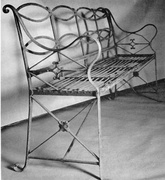
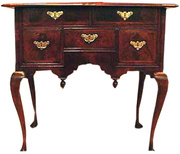 The International Influences of Buffalo Furniture
The International Influences of Buffalo Furniture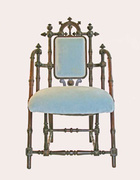
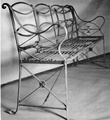 Wrought-Iron Furniture for English Gardens
Wrought-Iron Furniture for English Gardens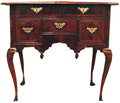 The International Influences of Buffalo Furniture
The International Influences of Buffalo Furniture John Werry Explains How To Appreciate Victorian Furniture
John Werry Explains How To Appreciate Victorian Furniture Victorian FurnitureAntique Victorian furniture refers to pieces made during the reign of Queen…
Victorian FurnitureAntique Victorian furniture refers to pieces made during the reign of Queen… Mari Tepper: Laying it on the Line
Mari Tepper: Laying it on the Line Nice Ice: Valerie Hammond on the Genteel Charm of Vintage Canadian Costume Jewelry
Nice Ice: Valerie Hammond on the Genteel Charm of Vintage Canadian Costume Jewelry How Jim Heimann Got Crazy for California Architecture
How Jim Heimann Got Crazy for California Architecture Modernist Man: Jock Peters May Be the Most Influential Architect You've Never Heard Of
Modernist Man: Jock Peters May Be the Most Influential Architect You've Never Heard Of Meet Cute: Were Kokeshi Dolls the Models for Hello Kitty, Pokemon, and Be@rbrick?
Meet Cute: Were Kokeshi Dolls the Models for Hello Kitty, Pokemon, and Be@rbrick? When the King of Comedy Posters Set His Surreal Sights on the World of Rock 'n' Roll
When the King of Comedy Posters Set His Surreal Sights on the World of Rock 'n' Roll How One Artist Makes New Art From Old Coloring Books and Found Photos
How One Artist Makes New Art From Old Coloring Books and Found Photos Say Cheese! How Bad Photography Has Changed Our Definition of Good Pictures
Say Cheese! How Bad Photography Has Changed Our Definition of Good Pictures Middle Earthenware: One Family's Quest to Reclaim Its Place in British Pottery History
Middle Earthenware: One Family's Quest to Reclaim Its Place in British Pottery History Fancy Fowl: How an Evil Sea Captain and a Beloved Queen Made the World Crave KFC
Fancy Fowl: How an Evil Sea Captain and a Beloved Queen Made the World Crave KFC
Sirs:
I have a bench similar to the fern design shown above. Along with the bench, i have the four matching chairs and table. I acquired these from my grandmother after she passed away in 1990. She had these on her front porch from at least the 1920’s or 30’s. They in great condition and have been well maintained and are currently being used by a pool in Dallas. This furniture is extremely heavy and requires at least two people to move the chairs and four to move the bench. Is there any way to get an approximate value as to their worth? If photos are needed,they can be provided.
Many thanks for your time.
Bruce Neustadt
I purchased an old iron bench 2 yrs. ago. It is so very heavy, it takes 4-5 men to lift and move it. But, it has a very interesting “pattern” to it. It has Fleur de lis, cowheads on the arms, hearts crosses,birds,and dogwood flowers. Can you tell me anything about it? I love it, it looks like it is trying to tell a story. Thank you!
I have a 19th century cast iron garden table with a laurel pattern (solomans seal) with griffin legs. I have seen only one like it online and would be interested in finding chairs for it. Apparently it is quite rare.
I recently purchased an iron table in South Louisiana. The words “chevillotte s jean leblanc loiret” are cast in the iron on the legs. Can anyone tell me where this piece may have originated? I would love to hear this tables story. Thank you!
I have a cast iron bench with square ornate sides very heavy. Chains hold a wooden slatted bench that swings from four short chains attached to the cast iron sides. I can’t seem to locate anything thing like this is my searches. Do you know anything about such a bench?
I have come across a outdoor bestro set through family memebers which has said to have come from the Dodge family. I am trying to find out some information about this set. It is that of a Roman or Grecian style set. Has four chairs and a round table. All of the chairs and table have urns (and or one urn) on the back of each chair. I have two chairs with arms and two without. I have researched quite a bit online – and to no avail found nothing. If anyone can help that would be greatly appreciated! Thank you!!
I have a cast iron folding bench frame with feet that were meant to be bolted down. The only markings on the two pieces are “Grand Rapids, MI” and patent no. 576204. We are trying to make the wooden back and seat for it and it would be helpful if we had a picture to go from. Any help would be most appreciated.
Are most of not all grape design lawn furniture made by Fiske. I just acquired a set.
Tks.
Mauldin
I have a cast iron plant stand marked ” Art Specialty Co.”, Chicago , ILL . It is very ornate and has a face inside of two motifs on the top . The sides have an oval with a urn in the center . The feet look like dog feet . I am thinking it is Victorian . I have searched all over the internet and can not find any information on the Art Specialty Co. of Chicago that made cast iron furniture . The only company I can find with that name in Chicago , is one that makes lighting fixtures . I e-mailed them and asked if the company made other things before they began manufacturing light fixtures in 1932 , but I have not received a reply . I would like to find out the age of my plant stand . I have seen only one other that is similar to mine on E-Bay . I sent the seller a message but they did not know any more about it than I do . The E-Bay listing has now ended . Is there anyone out that knows anything about the Art Specialty Co . of Chicago , ILL ? I could sure use some help with this one . Thanks —- Nancy
I have a small church pew (38″) in length. It has a wrought iron base to it that includes a cross within a circles. It was originally in the First Presbyterian Church in Stauton, VA. President Woodrow Wilson’s father was the pastor in this church at the time President Wilson was born. This pew is mid-late 1800’s. I imagine that it was a Rector’s seat. Any feedback welcome.
I have a cast iron park bench , I am replacing the wood on it . I was curious as to what stamped on letter ” A ” on each leg means ? Also one leg has a stamped ” I ” on it ? I have looked all over the internet and cannot find anything . Thanks Rick Bartalis
is there a book that will help me date some of the cast iron benches I have started to collect.
I live in Australia and I am having trouble finding information about them.
Thanks
Maurice.
I have a cast 4 piece set of lawn furniture. One large chair, 2 small chairs and a three leg table. They were all striped so I could paint and reassemble. The seats have a number and the legs have a four digit number and a single number on them. They say they are made in the USA. There is no manufacture name. Is there a way that I could find out the manufacture or what pieces go to what chair or table. Could you advise or comment on this problem. Thank you Don Coleman sr.
I’m replacing the wood on a bench with cast iron ends. The only marking I can find is a cross stamped on the inside of one of the legs
I purchased a very heavy bench that has A signature of John F Reilly and Charleston, SC on it. Do you know when these were made? Would you have it sandblasted and painted or would you leave it as is.
When did they make rose pattern cast iron garden furniture sets table chairs and bench I’ve had several sets extremely heavy .Where can I look them up and find year they were made .No markings that I could find